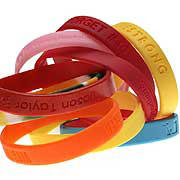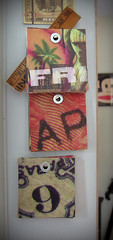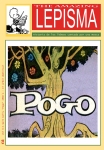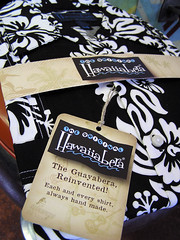
A who's who and what's what of sports bracelets. What started as a yellow 'LIVE STRONG' bracelet message through Lance Armstrong's foundation has grown into a rainbow of support through various colors, messages and materials. From baseball to diabetes research, the below guide decodes what your subway seat-partner may be supporting on his or her wrist.
MLB
Houston Astros— At the April 9 game, the first 20,000 fans were given a Believe bracelet, geared toward stroke awareness and sponsored by The Methodist Hospital. Astros outfielder Lance Berkman is a hospital spokesperson and not only helped endorse the bands but also wears one frequently. The bracelets, which are red or black, can also be purchased, with the proceeds earmarked for stroke research at the Methodist Neurological Institute.
Minnesota Twins— The club and the Twins Community Fund are selling red/blue rubber bracelets stamped with the words Go Twins! on one side and For The Twins Community Fund on the other. The Twins have sold 20,000 bands, raising almost $30,000 for the Twins Community Fund, the team's charity. The Twins' cost on each bracelet is $2, with approximately $1.50 going to the Fund to support youth baseball/softball programs initiatives.
NBA
Boston Celtics— I Am A Celtic green bracelet, along with donations at regular-season home games in April, raised more than $50,000 to donate to the family of Hector Paniagua, a Lawrence, Mass., high school basketball star who was shot outside a nightclub March 27th and left paralyzed. The rest of the proceeds go to the Boston Celtics Shamrock Foundation, which assists children in need in New England. About 36,000 have been sold.
San Antonio Spurs— Have sold 100,000 Spurs black bracelets, raising more than $139,000 for the Spurs Foundation, which supports physically, emotionally and economically underserved youth.
Washington Wizards— Their Pure Energy black bracelet raised more than $64,000, going to UNICEF for Tsunami relief.
WNBA
Houston Comets — The Comets will give away a pink bracelet to the first 5,000 fans at their Breast Health Awareness game on July 30. To raise money for the Pink Ribbon Fund, the Comets will do an auction on the concourse.
New York Liberty— Have sold 5,000 Liberty Cheering For Children sea-foam green bracelets at home games. The money goes to the Madison Square Garden Cheering for Children Foundation, which has committed to build 10 playgrounds throughout the New York metropolitan area.
NHL
Atlanta Thrashers— About 80,000 True Blue blue bracelets have been distributed over the last year, largely tied to community development programs. They were given out free at school assemblies, reading events and fan development functions.
Detroit Red Wings— The Believe red bracelet was produced by the Red Wings and Ilitch Charities for Children, with proceeds earmarked for children with cancer and AIDS. More than 50,000 have been sold. "Believe" was the Red Wings slogan following the 1997 Stanley Cup and the subsequent limousine accident that left player Vladimir Konstantinov and masseuse Sergei Mnatsakanov seriously and permanently injured.
College sports
Bowling Green— Two bracelets are the rage on campus: orange BGSU Falcons bracelets, $1.99 at the campus bookstore, and red Multiple Sclerosis Society bracelets, at $5, which were passed out by former BGSU hockey goalie Jordan Sigalet, who announced this past year he had MS.
Colorado— Head football coach Gary Barnett designed 250 black woven bracelets with DTRT (Do The Right Thing) stitched in white. He presented them to coaches, players and staff — after they had read a mission statement Barnett had written and agreed to honor the principles set forth.
Duke— About 33,000 Duke For Life blue bracelets have been sold, with the proceeds ($48,000) going to the Emily Krzyzewski Family Life Center. The mission of the Center is to create an environment that fosters the development of life skills that are fundamental to reaching one's highest potential. Coach K, who started the center in his mother's name, the Blue Devils coaching staff and the players all wear the bracelets.
Florida — Head football coach Urban Meyer worked closely with several student leaders on campus on a community service initiative and fundraiser surrounding the Spring Game (the Orange and Blue Debut). Student leaders sold orange and blue spirit bracelets, with proceeds benefiting the Children's Miracle Network. Fans could pick a color, then cheer for that respective team in the April 9 game. Fans who purchased the bands of the losing team (blue) were then asked to assist members of the UF coaching staff and football team in planting more than 400 crepe myrtle trees on Radio Road on campus.
Fresno State— The Student-Athlete Advisory Committee (SAAC) produced Fresno State Bulldogs red bracelets to raise money (as they had no budget) so they could provide more opportunities in terms of teambuilding and social activities for student-athletes. They have sold 3,500 at $2 each.
Michigan— The athletic department and C.S. Mott Children's Hospital have teamed up to sell blue M Go Blue for Mott bracelets to raise money for a new children's and women's hospital at the university. Football coach Lloyd Carr is co-chair of the Champions for Children campaign, with University Regent David Brandon, a former Wolverine football player.
Minnesota— Head basketball coach Dan Monson, a big admirer of the Live Strong bracelet, designed a special band for his team. The maroon bracelet, which was not available to the general public, was stamped with Mindset, and every letter stood for something. It became the credo for the basketball team.
M-Minnesota
I-Indivisible
N-Not about me
D-Discipline
S-Serve the Program and each other
E-Excellence
T-Thankfulness
Meanwhile, Minnesota's women's ice hockey team created their own blue Unbreakable bracelets, in honor of long-time equipment manager Bonnie Olein, who was diagnosed with colon cancer at the end of February. With the bracelets on their wrists, the Gophers won their second in a row NCAA championship. On July 12, the team will be honored at the White House, and Olein will be there with them.
Ohio State— The Buckeyes have jumped on the wristband wagon with numerous designs. The first bracelet, introduced last football season, is stamped with Tradition, People, Excellence, with more than 150,000 sold. Proceeds go to the Student Athlete Scholarship Fund. The latest bracelet projects include a "fan pack" band (You Win With People) and a three-pack (Go Bucks, Buckeyes, Hangonsloopy). Projected sales: 150,000 units, $250,000 in proceeds.
St. John's— When the St. John's baseball team played Notre Dame in a three-game series shown on ESPN and CSTV, the players wore purple Got Guts bracelets to honor a teammate, Matt Tosoni, who is redshirting this year. Tosoni was a starter in 2004 and had to sit out because of ulcerative colitis. The bracelets were purchased through a foundation that does work for people who have colitis.
Virginia— The athletic department's marketing and promotions office created two bracelets in the school colors — an orange Orange Fever bracelet and a blue Uncompromised Excellence bracelet. More than 15,000 have been sold at $2 each. The purpose was to continue to develop the Orange Fever brand and to participate in a national fundraising phenomenon on behalf of the United Way.
Washington State— The Cougars generated increased attendance at a men's and a women's basketball game by giving away 5,000 crimson bracelets stamped with Go Cougs. Says Leslie Cox, director of athletic marketing, via email: "We were very strict about the fact that going to the game was the only way to get a bracelet. Our attendance for both of those games increased significantly. Our fans still wear them, and we get requests all the time to do the bracelets again next year."
Western Michigan— Two years ago, as a sign of unity, the men's hockey team started wearing bracelets made from ice skate laces, an idea of Andrew Dwyer, now a senior defenseman. They fused together the ends of the laces by burning them with a match. When the team got knocked out of the playoffs, coach Jim Culhane proclaimed he would not take off his bracelet until Western Michigan advanced to the Super Sox Championships. Culhane and several players are still wearing their skate lace bracelets.
Individuals
Andy Baskin, one of the Fox Sports Net Ohio broadcasters, who works Cleveland Indians games, wears a blue bracelet for Cystic Fibrosis. His brother Bruce recently died from the disease.
"My brother bought 500 of them about two weeks before he went in the hospital," Baskin writes in an e-mail. "It was cool over the last four months to see all of the nurses at the clinic wear them. My family still wears it. For me, it's a constant reminder of what is important in life, and that every breath counts."
Angela Glazer, the wife of Tampa Bay Buccaneers executive vice president Joel Glazer, designed a blue bracelet to create awareness and educate people about endometriosis, a painful disease that affects 5 1/2 million women and girls in the USA and Canada and millions more worldwide. It occurs when tissue, like that which lines the uterus, is found outside the uterus, usually in the abdomen. The wording on the bracelets is Endrometriosis-Live Life-Think Positive.
Former NCAA champion breaststroker Dave Denniston wears his white Send It Forward bracelet to empower himself to walk again. He was paralyzed from the waist down in a sledding accident last February. The motto comes from a drill in a breaststroke training DVD he produced a few years ago. "The idea is to take all your energy and send it forward," explains says Denniston, who has sold 2,800 bracelets at $5 each and raised $15,000. That, with other fundraisers, will help pay for his rehabilitation at Project Walk in Carlsbad, Calif.
Jerome Bettis, Pro Bowl running back for the Pittsburgh Steelers, created a yellow and black tie-dyed bracelet, stamped with Bus & 'Burg Caring For Kids on the front and Bus36 on the back. A portion of the proceeds go to Bettis' "The Bus Stops Here Foundation," which funds programs that foster self-esteem and educational success in children.
Jason Taylor, Pro Bowl defensive end for the Miami Dolphins, created a red bracelet stamped with Jason Taylor Foundation. More than 7,000 bracelets have been given out, in exchange for a $1 donation per bracelet to the Foundation, which supports and creates programs for South Florida's children in need. The Foundation used the bracelets in conjunction with its "Big Screens-Big Dreams" program, inviting nine high school basketball teams to an advance screening of the movie Coach Carter. Each athlete was given a bracelet as their "ticket" into the theater.
Arizona Diamondbacks manager Bob Melvin wears a blue bracelet to create awareness for the Juvenile Diabetes Research Foundation. His 16-year-old daughter Alexi has juvenile diabetes. He and Alexi are spokespeople for the disease, and he's never seen without the bracelet.
Thanks to Jill Lieber, USA TODAY





























































No comments:
Post a Comment